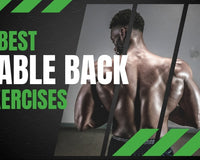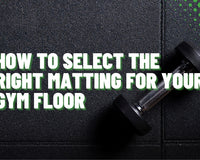If you want that muscular upper body and that thick neck, it's your trapezius muscles that you need to work out.
Now, your trapezius muscles actually consist of three separate parts that span a large area of your upper back and neck. There are the upper, middle, and lower trapezius regions.
Today, we're here to talk about the lower trapezius region. First, we'll take a closer look at what exactly the lower trapezius is and what functions it serves.
We'll then move on and take a look at some of the best lower trap exercises that you can do at home or at the gym.
Anatomy 101: The Trapezius

As mentioned above, the trapezius muscles consist of three separate parts, which are the lower traps, the mid traps, and the upper traps.
Upper Traps
So, to start with the non-essentials for the day, we have the upper trapezius. The upper trapezius features muscle fibers that run from your shoulder joints to the base of your skull.
The upper trapezius muscles are important for a variety of reasons, including neck rotation, lateral flexion, and extension of the neck, as well as for elevating and upwardly rotating the shoulder blades.
Related Post: Top 4 Best Trap Exercises For Bigger Traps
Mid Traps
We then have the mid or middle trapezius, which starts at the neck and upper spine vertebrae and attaches to your scapula.
The most important function of the middle traps is to pull back your shoulder blades and to maintain good posture.
Lower Traps
However, what we're really interested in for today is the lower trap or lower trapezius. As you can probably tell, this is the lowest section of the trapezius muscle, and it extends from your lower scapula to the middle of your back.
The lower trapezius muscles are important for a variety of reasons. First and foremost, this muscle is responsible for scapular depression, which involves pulling your shoulder blades down, and this is important for a variety of overhead activities.
Next, having a strong lower trapezius muscle is important for both scapular retraction and adduction, which is when your shoulder blades are drawn together towards the center of your body.
Yet another function of the lower trapezius muscles is upward rotation. Your lower trapezius is important for rotating the scapula upwards, which is important for lifting your arm above your head. Overall, the trapezius muscles are important for maintaining strong posture.
Related Post: Muscles Worked by Overhead Press
Benefits of Having Strong Lower Traps

Before we move on and talk about some of the best lower trap exercises for you to do, we do want to take a quick look at all of the benefits that you reap from having strong lower trap muscles.
- Having a strong lower trapezius muscle is important for both scapular depression and retraction, which involves pulling your shoulder blades back and down. This is important for overhead movements.
- Strong lower trapezius muscles are also crucial for helping you to maintain natural spinal alignment and for preventing your shoulders from rounding forward. It's all about good posture.
- In case you didn't know, your lower trapezius muscles counteract the upper trapezius muscles, which can often become overactive and tight due to poor posture. By keeping the lower trapezius strong, you reduce the overall risk of suffering musculoskeletal imbalances that could lead to rotator cuff injuries and other shoulder issues.
- Also interesting to note is that having a strong lower trapezius muscle can help to prevent and alleviate neck pain by reducing the amount of compensatory tension in your neck muscles. This is something that often occurs when you have a lower trapezius muscle that is weak.
- Something else worth considering when it comes to your lower trapezius muscles is that they are very important for anything that requires overhead motions, whether it be baseball, tennis, swimming, or just lifting those groceries over your head.
Relates Post: Improve Your Shoulder Flexibility With Deltoid Stretches
The Best Lower Trap Exercises
Now that we know exactly what your lower trapezius is and why it's so important, let's take a look at some of the best exercises to target your lower traps.
Face Pulls

The face pull is a very simple exercise where you attach a rope to a cable machine and then pull it towards your face. It's a great exercise to target your scapular retractors and your lower trapezius muscles. This is a good exercise because it also benefits your entire trapezius muscle from top to bottom, as well as your rear deltoids. It's a really great upper body exercise.
Instructions
- Stand facing a cable machine with your feet at shoulder width apart.
- Adjust the pulley so that it is at its highest position and attach a rope attachment to it.
- Hold the rope with both hands in a neutral position, which means that your palms are facing each other, and then take a step back. Your arms should be fully extended and you should already feel a bit of tension before you begin the exercise.
- Slowly pull the rope towards your face while keeping your elbows up and out. As you move towards your face, split the rope so that your hands end up at the sides of your face. The focus here should be on pulling your shoulders together and down.
- Hold this position for one or two seconds and then slowly return to the starting position. Aim to do anywhere between 12 and 15 repetitions for up to four sets.
The Prone Y Lift
Here we have a very interesting exercise that involves you lying face down on the ground and lifting your arms up into the shape of the letter why, which helps to target your lower trapezius muscles.
What's really cool about this exercise is that it can be done without any special equipment or weights.
It's a great exercise for isolating your lower trapezius muscles because it requires scapular depression and retraction, without involving other muscles.
Instructions
- Lay face down on a floor or on a flat bench, with your arms extended over your head, effectively forming the shape of the letter Y, while keeping your thumbs pointed upwards.
- While keeping your neck in a neutral position, engage your core.
- Lift your arms off the ground in a slow and controlled manner, with the focus being on squeezing your shoulder blades downwards and together.
- From this elevated position, hold it for two or three seconds, and then slowly return back to the starting position.
- Aim to perform anywhere between 8 and 12 repetitions, for up to three sets.
Inverted Row
If you're looking to target your lower trapezius muscles, doing an inverted row is always a good option.
Here, instead of pulling weights up to your body, here you are hanging off the barbell, such as a Smith machine, and then pulling yourself upwards. It's almost like a reverse push-up.
This is a great exercise because it targets your entire back and core, but especially your lower trapezius muscles.
Instructions
- Go to a Smith machine and set the bar so that it is at waist height. You then want to lie underneath it, roughly at chest level.
- Using an overhand grip, and keeping your hands just wider than your shoulders, hold the bar.
- Make sure that your body stays perfectly straight, almost like a reverse plank, so that your core is engaged.
- Focusing on pulling your shoulder blades together, pull yourself up towards the bar, and hold the position for one or two seconds.
- In a slow and controlled manner, lower yourself back down, and aim to perform up to 12 repetitions, and up to three sets.
Related: 4 Best Side Delt Exercises
Wall Slides
If you're someone who has limited strength and mobility, and you want to start slow, then doing wall slides is a great way to go. Wall slides don't involve any impact, and they're great for improving your overall strength and mobility in your lower trapezius. By encouraging scapular movement they activate your lower trapezius.
Instructions
- Start by standing with your feet at shoulder width apart, with your back against a wall.
- While keeping your arms bent at a 90° angle, place your hands, forearms, and elbows against the wall.
- In a slow and controlled manner, slide your arms upwards and backwards, making sure that they remain pressed against the wall. Once you reach the top, you can then slide back down.
- All throughout the movement, your shoulder blades should be pulled back and down.
- Repeat this exercise for up to 15 repetitions and up to five sets.
Rear Delt Cable Raise
Although this exercise is called the rear delt cable raise, and although it does target your rear delts and is one of our top cable shoulder exercises, it's also a fantastic exercise for your lower trapezius. Let's find out how to do it.
Instructions
- Go to a cable machine and adjust the pulley so that it is at its lowest position, and then attach a single handle to it.
- Hold the handle with your right hand and your palm facing you. Make sure to keep your elbows slightly bent, and also bend at your waist until your torso is almost parallel to the ground. Your knee should also be slightly bent.
- As you exhale, raise your right arm up while keeping your elbow bent just slightly, until your upper arm is parallel to the floor and at ear level.
- Hold this position for one or two seconds and then slowly return back to the starting position. Repeat this movement 12 to 15 times, and for up to three sets.
Related: Upright Row - Muscles Worked
Final Thoughts

The bottom line is that although your lower trapezius muscles might not be the first thing you think of working out when you go to the gym, they should not be ignored.
As you can see, this is a very important muscle for a number of reasons, and in all reality, it's not all that hard to work it out.





